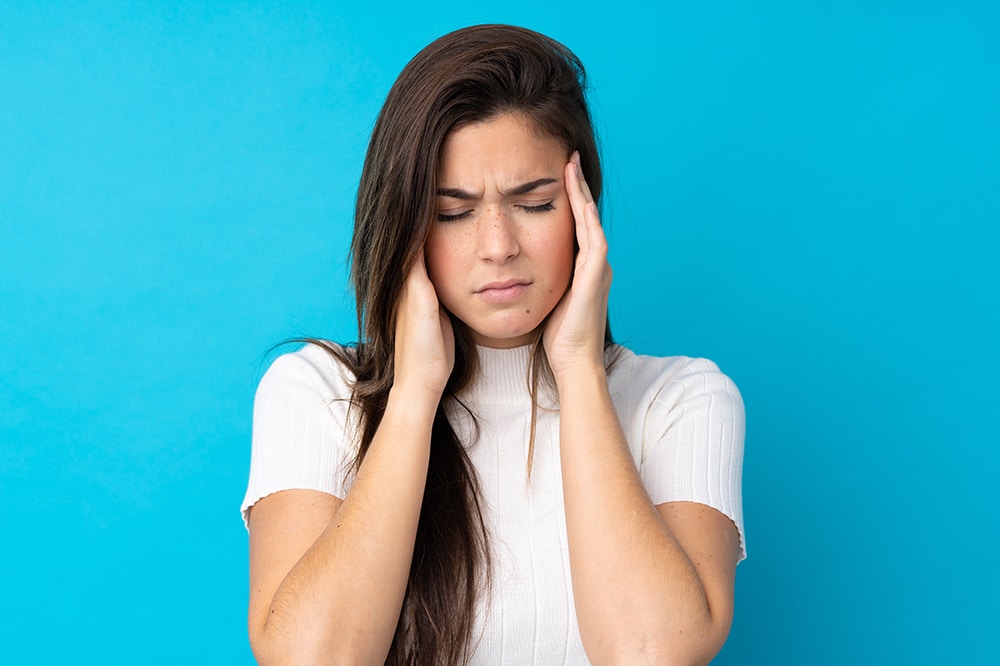Headaches and Migraines
New Patient consultations for headaches and migraines available this week!
Reviewed by: Dr. Ella Akkerman
Seeing patients from across Northern Virginia, including Reston, Herndon, Fairfax, Sterling, Chantilly, and Leesburg
Headache and Migraine: Quick Facts
- What’s the difference between a headache and migraine? A migraine is a specific type of headache with severe, throbbing pain, often accompanied by other symptoms like nausea, vomiting and sensitivity to light and sound. Headaches are a broader term for head pain, with tension headaches being the most common type, typically causing a less intense, dull pressure on both sides of the head without the same associated symptoms.
- How long do migraines last? Typically, a migraine headache lasts between 4 and 72 hours. However, the entire migraine episode that precede and follow the migraine can last for days, sometimes triggering further headaches or migraines or other symptoms.
- When are migraines considered chronic and I should see a specialist? Migraines are considered chronic when you experience them on 15 or more days per month for at least three months, or when they disrupt your daily life. You should seek care from a neurologist if your headaches are becoming more frequent, your current treatment is becoming less effective, or you have a headache accompanied by neurological symptoms like confusion, weakness or vision changes. It’s vital to seek immediate medical help for sudden, severe headaches or any headache that comes with fever, stiff neck or confusion.
Learn More about Migraines from Dr. Akkerman, VSI’s Neurologist
What is a Migraine?
Migraines are the sixth most disabling illness worldwide, affecting nearly 40 million Americans and approximately one in every four households. More than just a headache, a migraine is a complex neurologic disorder. It not only causes pain, but it can also result in light and sound sensitivity, vision changes, difficulty concentrating, nausea, vomiting, and other neurologic symptoms. Certain triggers can alter the brain’s ability to maintain its chemical balance. Once this balance is overwhelmed, a migraine may occur.

What Are Common Migraine Symptoms?
Common symptoms of Headaches and Migraines include:
- Moderate to severe pain, often on one side of the head but can also be located behind the eyes, along the temples or at the back of the neck
- Pounding or throbbing sensation
- Changes in vision, called an aura. These effects can include streaking lines, blurred vision or fog.
- Sensitivity to light, sound and certain odors
- Nausea or vomiting
Migraine symptoms can even manifest without the typical head pain, often called a silent migraine. All of these symptoms can add up for a pretty miserable experience, and inevitably cause a patient to call out of work or impede them from accomplishing their daily activities.

When Should You Seek Treatment for Migraines?
Migraines are considered chronic when you experience them on 15 or more days per month for at least three months, or when they disrupt your daily life. You should seek care from a neurologist if your headaches are becoming more frequent, your current treatment is becoming less effective, or you have a headache accompanied by neurological symptoms like confusion, weakness or vision changes. It’s vital to seek immediate medical help for sudden, severe headaches or any headache that comes with fever, stiff neck or confusion.
What are Common Causes of Migraines?
Our brains work at their best when they can maintain a chemical balance. Stress from outside the body (arguments, work deadlines, etc.) and inside the body (hormones) can overwhelm the brain’s ability to keep this balance. When the brain cannot maintain this balance, it releases proteins that lead to pain and other symptoms.
Certain triggers can throw off the brain’s pain regulation – this disruption causes a release of many substances that trigger a sensation of pain that spreads throughout the brain. In patients with migraines, avoiding headache triggers is a major part of managing their attacks. Once you identify your triggers, you can work on reducing them and having fewer migraines. Many patients have found it helpful to keep a diary of what triggers set off each migraine attack.
Below is a list of the four most common migraine triggers.
- Caffeine and alcohol
- Stress (a trigger for almost 70% of people with migraines)
- Irregular sleep schedule
- Hormones (migraines are far more common in women)
WebMD turned to Dr. Akkerman for tips on how to improve your quality of life if you suffer from chronic headaches and migraines.
“You don’t have to ‘tough it out’ or feel dismissed. We’ll work with you and find an approach to your migraine to allow you to live happily ever after. Don’t feel that you’re alone in this, and don’t lose hope. We’re here to help.”


How Are Migraines Diagnosed?
Migraine is diagnosed clinically based on the description of the headache and the symptoms associated with it. Headaches lasting 4 – 72 hours, occurring at least 5 times, and having some of the following characteristics are consistent with migraines:
- Pain on one side of the head
- Pulsating, throbbing pain
- Moderate to severe pain
- Worsening pain with physical activity (such as climbing stairs or walking)
- Pain associated with nausea or vomiting
- Pain associated with light or sound sensitivity
What are Common Treatments for Migraines?
While every patient’s care is unique to them, we do have many ways we can help treat and even prevent migraines.
Common migraine treatments include:
- Avoid triggers as best as possible
- Over-the-counter pain medications (do not take more than three days out of the week as this can cause rebound headaches)
- Prescription migraine medications
- Physical therapy
- Hyperbaric Oxygen Therapy
- Botox Injections
- Intranasal, subcutaneous, or intravenous medications if necessary
Frequently Asked Questions about Migraines


